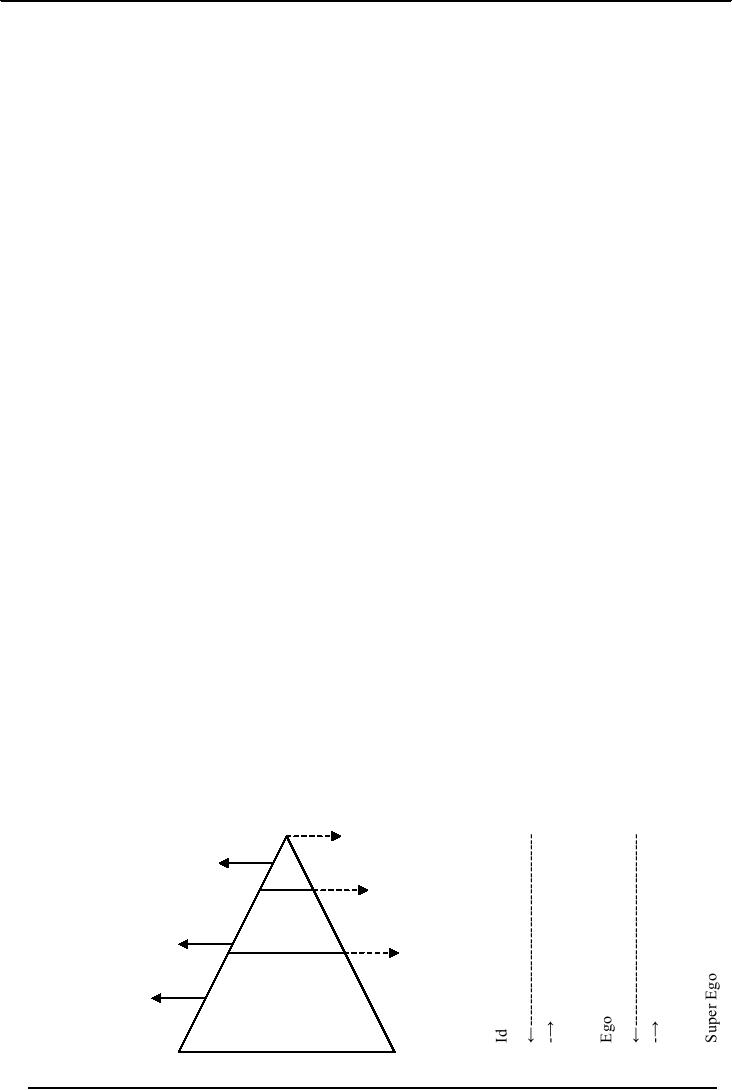 |
SIGMUND FREUD: A PSYCHOANALYTIC THEORY OF PERSONALITY |
| << MAIN PERSPECTIVES:Psychometrics, observation, Behavioral Coding Systems |
| INSTINCT: WHAT MOTIVATES HUMAN BEHAVIOR?, The Oral Stage >> |

Personality
Psychology PSY 405
VU
Lesson
4
SIGMUND
FREUD: A PSYCHOANALYTIC THEORY OF
PERSONALITY
His
main contributions are as
follows:
1.
Theory of personality
2.
Method of treatment- Psychoanalysis
3.
Set of clinical observations (e.g.,
defenses)
4.
Methods of investigation (free
association, dream analysis)
Freud's
Theory of Personality-Major
Assumptions
1.
Psychic determinism--all
our behavior has a
purpose
2.
Unconscious motivation--universally
accepted
3.
Freud emphasized the
predominance
of
unconscious motives
and processes -
Recent
translation into cognitive
psychology
The
Theory of Consciousness
Original
theory is based on experience with
hypnosis and early treatment of hysteria.
Sigmund Freud, a
young
Viennese physician, he theorized
that individuals are in a
perpetual state of conflict
motivated by
their
unconscious sexual and aggressive
urges.
Freud
with his active writing and
clinical practice developed:
(1)
The first comprehensive personality
theory
(2)
An extensive body of clinical
observations based on his therapeutic
experience and self-analysis
(3)
A compelling method for treating
mental or behavioral disorders
(4)
A procedure for the investigation of
mental processes which are
almost inaccessible in any other
way.
Freud's
personality theory and its
underlying assumptions will be
examined.
Biographical
Sketch
Sigmund
Freud was born May 6, 1856,
at Freiberg, a small Austrian
town now part of
Czechoslovakia.
When
he was four years old,
his family suffered
financial setbacks and moved to
Vienna. He remained a
resident
of that city until he
migrated to England in 1938. He
was the oldest of seven children,
although his
father
had two sons by a former
marriage and was a grandfather
when Sigmund was
born.
From
a very early age, Freud
excelled as a student. Despite the limited
financial position of his
family
which
forced all members to live
in a crowded apartment, Freud had his
own room and even an oil
lamp to
study
by. The rest of the family
made do with candles. Like
other young people of his
time, he had a
classical
education, studying Greek
and Latin and reading the
classics of various countries. He had a
superb
command
of the German language and fluency in French, English,
Spanish, and Italian.
Freud
recalled that he often had
childhood dreams of becoming a great
Austrian general or minister of
state.
He reluctantly decided upon a medical
career and entered the Faculty of
Medicine of the University
of
Vienna in 1873. He received
his M.D. degree in 1881. In
1880 he began working with
Breuer.
The
year 1885 marked an important
turning point in Freud's career,
for it was then that he
went to Paris to
study
hypnosis a method of treatment which eliminated
hysterical neurotic symptoms.
Freud later rejected
hypnosis
as a therapeutic technique and developed
the method of Free Association,
resistance, dream
analysis,
transference and counter-
transference.
In
1886 he married Martha Bernays he had
six children and his
daughter Anna Freud is a
famous child
psychiatrist.
In 1895 he published book
called studies in Hysteria and in
1897 he began his self
analysis but
the
year 1900 is important
because his most famous
book called interpretation of
dreams was published.
In
1909
Freud was invited by Stanley
Hall to deliver a series of lectures on
Psychoanalysis this provided
him
17

Personality
Psychology PSY 405
VU
an
opportunity to familiarize his
brand of psychology internationally. He
in 1923 discovered he had cancer
of
the mouth and went through
some 33 operations he died in
1939.
Levels
of Consciousness
(How
Personality Is Organized?)
For
a long time in the theoretical
development of psychoanalysis, Freud
employed a topographical
model
of
personality organization. According to
this model, psychic life can
be represented by three levels of
consciousness-the
conscious, the preconscious, and the
unconscious. Freud used this
mental "map" of the
mind
to describe the degree to which
mental events such as
thoughts and fantasies vary in
accessibility to
awareness.
The
conscious
level
includes
all the sensations and
experiences of which we are
aware at any given
moment.
Freud insisted that only a
small part of mental life
(thoughts, perceptions, feelings, memories)
is
contained
in the realm of consciousness. Whatever
the content of conscious experience may be
for a given
person
at a given time, it is the result of a
selective screening process largely
regulated by external
cues.
Moreover,
it is actually conscious only
for a brief time and can be
quickly submerged into
preconscious or
unconscious
levels as the person's attention
shifts to different cues. In short, the
conscious represents a
small
and limited aspect of
personality.
The
preconscious
domain,
sometimes called "available
memory," encompasses all
experiences that are
not
conscious
at the moment but which can
readily be summoned into
awareness either spontaneously or with
a
minimum
of effort. This might
include memories of everything
you did last week, your
Social Security
number,
all the towns you ever
lived in, your favorite
foods, and a host of other
past experiences. In Freud's
view,
the preconscious bridges the unconscious and
conscious regions of the mind. For
example, under the
influence
of certain therapeutic techniques,
unconscious material may
emerge into the preconscious
and
from
there become conscious.
The
deepest and major stratum of the human
mind is the unconscious. Freud
was not the first to
focus
attention
on the importance of unconscious
processes in understanding human actions; several
eighteenth-
and
nineteenth-century philosophers had
suggested the influence of unconscious
experience on behavior.
Unlike
his philosophical predecessors,
however, Freud gave the concept of an
unconscious life an
empirical
status.
Specifically, he contended that the
unconscious must not be
conceived as a hypothetical
abstraction
but
rather as a reality which can be
demonstrated and thus proved.
Freud firmly believed that
the really
significant
aspects of human behavior are
shaped and directed by impulses and
drives totally outside
the
realm
of awareness. Not only are
these forces unconscious,
but there is great resistance within
the
individual
to their ever becoming
conscious. In contrast to preconscious
modes of thought,
unconscious
ones
are completely inadmissible to
awareness, yet they largely
determine the actions of people.
However,
unconscious
material may be expressed in disguised or
symbolized form, an insight
that Freud utilized
in
his
work with disturbed persons.
Psychoanalysis thus emphasizes the
interpretation of fantasies and
dreams
as
avenues for deeper
understanding of the unconscious
processes underlying
behavior.
Levels
of Consciousness:
Consciousness
Preconscious/
Sub
conscious
Unconscious
18

Personality
Psychology PSY 405
VU
According
to this triangle, the top
smallest part is the conscious experience
the middle small layer
is
subconscious
and the largest portion is
unconscious.
According
to Freud that part of the
mind about which we are
aware is consciousness but it is a
small part of
mental
life. You are listening to me it is
your conscious mental
activity. The preconscious
are thoughts or
activities
that are easily made
conscious by an effort to remember or
say, you have the present
lecture's
handout
in front of you and you
are conscious that you
are writing on it. The
largest segment is the
unconscious
not easily reachable /
accessed yet it gives rise on to
important needs and influences
our
behavior.
Example:
All
your nightmares, phobias, fears which
influence you but why
you have them is because of the
unconscious,
you don't have an answer. Freud
suggested ways / techniques of reaching the
unconscious
Example:
You
stand near a river, the top
water is the conscious part,
fill out some muddy
water in container, it is the
sub-conscious
and when you dug the river
bed and find something buried in it well
that is the
unconscious
part.
The
Anatomy of Personality
The
concept of unconscious mental
processes was central to
Freud's early description of
personality
organization.
However, during the early
1920s he revised his conceptual
model of mental life
and
introduced
three basic structures in the anatomy of
personality: id, ego, and super
ego.
The
Id:
The
word "id" comes from the
Latin word for "it" and
refers exclusively to the biological component
of
personality.
The id is the mental agency containing
everything inherited, present at
birth, and fixed in the
individual's
constitution- especially sexual and
aggressive instincts. It is raw,
animalistic, and unorganized,
knows
no laws, obeys no rules and remains basic
to the individual throughout
life.
Freud
identified two mechanisms the id
employs to rid the personality of
tension: reflex
action and
primary
process.
In
the former, the id responds
automatically to sources of irritation,
thereby promptly removing
the
tension
which the irritant elicits. Examples of
such inborn reflex
mechanisms are sneezing,
coughing, and
blinking.
Id is the unorganized reservoir of wishes
or passions related to our sexual and
aggressive drives, it
strives
for immediate gratification
that bypasses demands of
reality, order logic and
reason. The Id is like
a
child
when it wants something it
wants it there and then without regard
for consequences, so Id operates
on
pleasure
principle.
This
refers to Greek concept of hedonism
meaning pleasure. The energy
within the Id is labeled as
the
libido.
The Id has its own
characteristic way of processing
information, cognitive style
referred as primary
process.
The thinking patterns of Id
are illogical, irrational,
emotional immature and purely
selfish.
The
Ego:
The
ego is that portion of the psychic
apparatus that seeks to
express and gratify the
desires of the id in
accordance
with the restrictions of both
outer reality and the
superego. The ego acquires
its structure and
functions
from the id, having evolved
from it, and proceeds to
borrow some of the id's energy
for its own
use
in response to the demands of the
environment. Ego thus
assures the safety and self-
preservation of
the
organism. In its battle for
survival against both the external
world and the instinctual demands of the
id,
ego
must continuously differentiate between
things m the mind and things in the
outer world of reality.
The
hungry
man in search of food, for
example, must distinguish between a
mental Image of food and an
actual
perception
of food if tension reduction is to
occur.
The
ego operates according to the reality
principle and the cognitive operations of the ego
are characterized
by
logic, reason and are
referred as the secondary process.
The ego is the master control, it tries
to resolve
conflicts
between t he demands of Id with in the
permitted boundaries of super ego.
19

Personality
Psychology PSY 405
VU
The
ego has the role to mediate
conflict between the Id and super ego
according to realities of the world.
If
it
mediates successfully, we see an
intelligent, creative individual
who is well adjusted while if ego
is
unsuccessful
either Id or super ego will be
strong.
If
Id is strong, we see an antisocial
criminal and if super ego is strong we
see a pure, rigid,
nonflexible
individual.
Super ego is the storehouse of moral and
ethical standards taught by
parents, teachers and
culture
(it also refers to the conscience of the
psyche). It operates according to the
moral Principle when
we
do
something wrong, when ethical,
moral standards are violated
than super ego generates
guild.
Example:
You
go to a garden where you see red roses
you face intra-psychic
conflict
Id→
Ego↔
Super
Ego
I
want red rose and I want I
can afford to buy red roses
Stealing is bad. The sign
says
it
now.
from
flower shop
don't
pluck flowers.
Example:
You
go to a store you see a
lovely jacket but the price
is high but no one is looking
you face
intra-psychic
conflict:
Example:
Id→
Ego↔
Super
Ego
I
want the jacket and I I have to be
realistic I Stealing is bad.
want
it now.
cannot
afford the jacket.
The
Superego
In
order for a person to
function constructively in society, he or
she must acquire a system of
values,
norms,
ethics, and attitudes which are
reasonably compatible with that
society. These are acquired
through
the
process of "socialization," and in
terms of the structural model of
psychoanalysis are developed
through
the
formation of a superego. The
superego is the last major system of
personality to be developed and
represents
an internalized version of society's
norms and standards of behavior. In
Freud's view, the human
organism
is not born with a superego;
rather, children must
incorporate it through interactions
with parents,
teachers,
and other 'formative" figures. As the
moral-ethical arm of personality, the
superego results from
the
child's prolonged dependence
upon parents. It makes its
formal appearance w en the child is
said to
know
right from wrong, good
from bad, moral from
immoral.
20
Table of Contents:
- THE NATURE OF PERSONALITY THEORY:Objectives of Personality Psychology
- PERSONALITY MEASUREMENT:Observational Procedures, Rating Scales
- MAIN PERSPECTIVES:Psychometrics, observation, Behavioral Coding Systems
- SIGMUND FREUD: A PSYCHOANALYTIC THEORY OF PERSONALITY
- INSTINCT: WHAT MOTIVATES HUMAN BEHAVIOR?, The Oral Stage
- PSYCHOANALYTIC THEORY OF SIGMUND FREUD:The Ego, Free association
- THEORY OF CARL JUNG:Biographical Sketch, Principles of Opposites, The Persona
- THE PSYCHOLOGICAL TYPES:Childhood, Young Adulthood, Middle Ages
- ALFRED ADLER:Biographical Sketch, Individual Psychology, Feeling of Inferiority
- INDIVIDUAL PSYCHOLOGY:Fictional Finalism, Social Interest, Mistaken Styles of Life
- KAREN HORNEY:Adjustment to Basic Anxiety, Adjustment Techniques
- ADJUSTMENT TO BASIC ANXIETY:Moving Towards People, Moving Against People
- ERIK ERIKSON:Anatomy and Destiny, Ego Psychology, Goal of Psychotherapy
- ERIK ERIKSON:Human Development, Goal of Psychotherapy
- SULLIVAN’S INTERPERSONAL THEORY:Core Concepts, The Self-System
- SULLIVAN’S INTERPERSONAL THEORY:Cognitive Process, Tension
- CONSTITUTIONAL PSYCHOLOGY:The Structure of Physique, Evaluation
- SHELDON’S SOMATOTYPE THEORY:The Structure of Physique
- MASLOW’S THEORY:Self-Actualizers Aren't Angels, Biographical Sketch
- MASLOW’S THEORY:Basic Concepts of Humanistic Psychology, Problem Centering
- ROGERS PERSON CENTERED APPROACH:Humanistic, Actualizing tendency
- ROGERS PERSON CENTERED APPROACH:Fully functioning person
- ROGERS PERSON CENTERED APPROACH:Client Centered Therapy,
- KELLY’S COGNITIVE THEORY OF PERSONALITY THEORY:Biographical Sketch
- CORE CONCEPTS OF GEORGE KELLY’S COGNITIVE THEORY OF PERSONALITY
- GORDON ALLPORT: A TRAIT THEORY OF PERSONALITY:Personality as a
- GORDON ALLPORT: A TRAIT THEORY OF PERSONALITY:Secondary Traits
- FACTOR ANALYTIC TRAIT THEORY:Factor Analysis, The Nature of Personality
- FACTOR ANALYTIC TRAIT THEORY:The Specification Equation, Research Methods
- HENRY MURRAY’S PERSONOLOGY:Need, Levels of Analysis, Thema
- HENRY MURRAY’S PERSONOLOGY (CONTINUED)
- ALBERT BANDURA’S SOCIAL LEARNING THEORY:BIOGRAPHICAL SKETCH
- ALBERT BANDURA’S SOCIAL LEARNING THEORY:Reciprocal Determinism
- THE STIMULUS RESPONSE THEORY OF DOLLARD AND MILLER:Core Concepts
- THE STIMULUS RESPONSE THEORY OF DOLLARD AND MILLER:Innate Equipment
- SKINNER’S THEORY OF PERSONALITY:Biographical Sketch, Books
- SKINNER’S THEORY OF PERSONALITY:Positive Reinforcement, Generalization
- ALBERT ELLIS THEORY OF PERSONALITY:Biographical Sketch, Social Factors
- THE GRAND PERFECT THEORY OF PERSONALITY:Genes and Biology
- PERSPECTIVES OR DOMAINS OF PERSONALITY PSYCHOLOGY:Dispositional
- PERSPECTIVES OR DOMAINS OF PERSONALITY PSYCHOLOGY
- PERSPECTIVES OR DOMAINS OF PERSONALITY PSYCHOLOGY:Need
- THE GRAND THEORY OF PERSONALITY:Psychosexual Stages of Development
- PERSONALITY APPRAISAL:Issues in Personality Assessment
- PERSONALITY PSYCHOLOGY: NEW DIRECTIONS IN THE DISCIPLINE